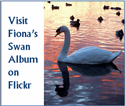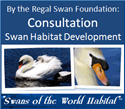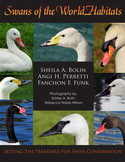Ask the Swan Specialist
Date: 7 February 2017
Hi Barbara:
There is always the possibility that park staff or someone is taking the young birds from the park to control the population. Australian Black Swans are not native to Louisiana and they produce two broods of cygnets yearly. This would cause the population to overrun the pond. If this is not the case, then predators such as owls, hawks, otters, raccoons, egrets, herons, soft-shelled and snapping turtles, alligators, etc., could be killing the young birds.
In any case, we would strongly suggest that the young birds Not be taken from their parents. If a cygnet is raised in a captive setting without the parents, it means that the cygnet will not be able to survive on its own as humans cannot teach the birds about predators or how to avoid them. Additionally, the birds will become imprinted on humans (meaning they think that they are a person rather than a swan) and will require constant care by humans.
If it is permissible, you might build a pen (1/2 in water 1/2 on land, no steep banks, enclosed completely top to bottom so that predators cannot climb over or dig under the pen to access the swans. The outside perimeter of the pen should have plastic poultry fencing from the bottom rail of the pen up to approximately 4 feet. This will keep the young birds from crawling out of the pen, getting away from the parents and not being able to get back in). The poultry fencing will also prevent raccoons from reaching into the pen and accessing the swans.
A feeder should be placed in the pen for the birds to feed and the feeder must be checked regularly to keep mold or ants from the feeder. The swans should be fed a mixture of 50% cracked corn (provides necessary Vitamin A so that they do not develop neurological problems and acts as a filler) and 50% poultry layer pellets which provide necessary mineral, vitamin and micro-nutrients. Lettuce should be offered as a vegetative supplement.
The pen should be approximately 12 feet wide by 24 feet long (12 feet on land and 12 feet in water for bathing and feeding). The nest should be built from straw and placed on the land part of the pen.
Now, having said all of this, there is no guarantee that the swans will nest in the pen. In fact, they may wait until they are released from the pen to nest or the birds may skip the entire breeding season if they do not like being enclosed. Additionally, penned swans require an enormous amount of labor to ensure that they have proper food on a daily basis, the young birds do not get caught in the pen or sustain other injuries from being placed in a pen.
So, basically, unless you have the manpower and proper veterinary care, pen etc., there really are no guarantees that the young swans will survive, but this will certainly help. Once the cygnets are approximately 3-4 months of age, the entire family can be released onto the pond.
Finally, since the Australian Black Swans can produce two broods a year, once the cygnets are two years of age, they will also be able to produce two broods and this will result in an enormous amount of swans in which you may need to find a suitable home once the sustainable numbers of swans on the pond is maintained. In some states, you may even need a breeder's license to maintain and sell/give away swans. The Regal Swan
Messages In This Thread
- Keeping black swan cygnets alive until they're big enough to fend for themselves -- Barbara -- 6 February 2017
- Re: Keeping black swan cygnets alive until they -- The Regal Swan -- 7 February 2017
Ask the Swan Specialist is powered by
Tetra-WebBBS 5.30 Beta © 2006-2007 Tetra-Team






